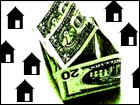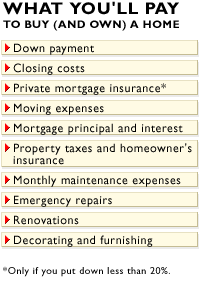
NEW YORK (CNN/Money) -
The house is perfect: it feels right, it's in the right neighborhood, and it's got those star-gazing skylights you've always dreamed about. You must have it.
The only question is whether you can afford it.
The answer has to do with far more than the down payment and how big a mortgage you're told you can get. In fact, just because a lender tells you that you can borrow a bazillion dollars doesn't mean you should.
That's because buying a home is probably not your only financial goal. You still have to fund your retirement and you may want to help pay for your kids' educations, not to mention take a vacation or two. Committing every last dollar to the roof over your head can make for financial frustration at best, disaster at worst.
Here's a quick guide to help you assess how much home you can really afford without committing yourself to the poorhouse.
Step 1: Make friends with reality
Before running off to see every cute colonial on the market, get estimates from lenders of how much you can borrow and then get a loan preapproval. "Why not couch the entire process in reality?" said Barbara Steinmetz, a certified financial planner and former real estate broker. Otherwise, you'll waste time falling in love with houses out of your league, which can be "frustrating and demoralizing emotionally," she said.
There are no absolutes that mortgage lenders apply in assessing a potential borrower's eligibility, but there are some general guidelines that can help you figure out whether you're a candidate for some of the best loans. (For a ballpark estimate, try our Mortgage Qualifier.)
| RELATED CALCULATORS
|

|
|
|
|
For starters, the better your credit score, the better your chances of getting a favorable deal. Typically, too, a mortgage lender uses two ratios to assess the risk you'll default on a mortgage. The first is the ratio of your total monthly housing costs to your total monthly gross income. Ideally, your expected housing costs -- namely, the mortgage principal, interest, taxes and homeowner's insurance (PITI) -- shouldn't exceed 28 percent of your income, although many lenders may allow up to 33 percent, according to Eric Tyson, coauthor of "Mortgages for Dummies." The second is a debt-to-income ratio. Ideally, your total monthly debt -- including your expected housing costs plus credit card bills and loan payments -- shouldn't exceed 38 percent of your gross, and preferably not more than 36 percent.
Having said that, there are numerous programs designed to help low-income consumers and those with weak credit obtain an affordable mortgage. For example, Freddie Mac, a government-established company that buys mortgages from banks, offers programs that do not apply a maximum on the housing-to-income ratio, that raise the cap on the debt-to-income ratio and that let home buyers obtain mortgages for as little as 3 percent down.
By learning which loans you qualify for, you can better assess the maximium price of the homes you should be looking at. "Now you can narrow the market," Steinmetz said.
Step 2: Learn to love gutters and lawyers
Say you've got $60,000 saved for a new home and a bank willing to lend you up to $240,000. You figure you could look at homes priced up to $300,000, right?
Not so fast.
Two of the most shocking realizations for new home buyers is the cost of buying a house and the cost of owning it. First there's the down payment, often tens of thousands of dollars. And if you put down less than 20 percent of the purchase price, you'll end up paying monthly for private mortgage insurance (PMI), which protects the lender against the possibility you'll default.

On top of that, you'll pay anywhere from 2 to 5 percent of the purchase price in closing costs, which include inspections, discount loan points and lawyers' fees.
Once you get the keys, you may pay far more, depending on how much renovation and redecorating you'd like to do. Then there's the cost of maintaining your home and making repairs -- everything from gutter cleaning, lawn care and termite inspection to replacing the water heater.
So, in calculating how much home you can afford, factor in the cash cushion you'll need once you're through yelling at the movers for scratching your new floor. Tyson recommends having at least three months' worth of expenses on hand to help pay for maintenance and emergency repairs. And, indeed, a lender will insist you have some cash reserves left over after the closing.
Step 3: Flirt with the future
"Yeah, yeah, o.k.," you say, still stuck on the house. "I'll make the numbers work."
Alright then. Start working. Estimate what your monthly payments would be if you actually had a $240,000 mortgage and then live for at least three months as if you had to make those payments, Steinmetz suggests. This dry-run serves two purposes: first, you get a good sense of what your cash flow would be with a mortgage that size; and second, you'll save more money toward a new home by socking away the difference between your current house payments and your imagined ones, Steinmetz said.
| RELATED ARTICLES
|

|
|
|
|
In calculating your monthly payments, don't just count the principal and interest on your mortgage, the property taxes and the insurance. Estimate, too, how much it will cost to heat -- or cool -- your new home. And factor in all your other expenses -- from your commute to your club memberships. Don't neglect your retirement account, either, and, if you have kids, continue to put aside money for college if that's a priority. And remember, you're no monk. You'll probably still want to buy new clothes, go to the movies, eat out and indulge your love for pricey gizmos.
If, after all this, you find yourself running short every month, then you'll know you either have to make some lifestyle changes or you have to get a smaller mortgage.
Step 4: Remember, 'hock' is a bad word
Given all these costs, that $300,000 house may be out of your league. Take closing costs alone. Assume you have $10,000 in closing costs (3.3 percent of purchase price); that reduces your $60,000 in savings to $50,000. Coupled with a $240,000 mortgage, that would only add up to $290,000. You'd have to borrow more money to buy the house, and you'd have to take out PMI since $50,000 is only 16.6 percent of $300,000.
But even if you know you can afford the monthly payments a $240,000 mortgage incurs, you have an emergency fund on top of your $60,000 and you're willing to put down less than 20 percent, Steinmetz suggests looking for homes that are slightly less than you can afford. Here's why: Real estate brokers, she explained, often show clients homes that are more expensive than the client's stated price range. So it's better to set your ceiling lower than your real top limit. That way, if you tell your broker you don't want to spend more than $275,000 but are shown a $290,000 house you love, you've left yourself wiggle room to make a bid.

|

